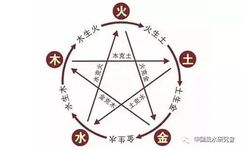Knowledge of the Five Elements
Interactions of the Five Elements
Metal, Wood, Water, Fire, Earth
Generative Cycle of the Five Elements: Wood generates Fire, Fire generates Earth, Earth generates Metal, Metal generates Water, Water generates Wood
Controlling Cycle of the Five Elements: Wood controls Earth, Earth controls Water, Water controls Fire, Fire controls Metal, Metal controls Wood
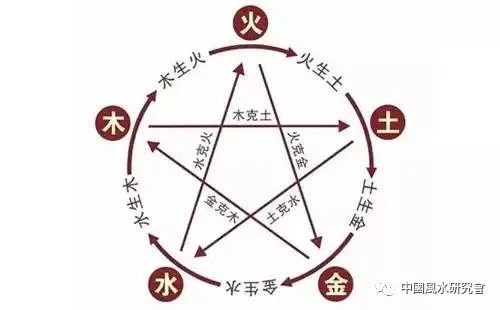
(1) Characteristics of Wood
Wood says: “Curved and Straight”. Curved means bending; straight means extending. Therefore, wood has the ability to bend and stretch. Wood absorbs the energy of water and earth, allowing it to grow and develop. Thus, wood also possesses the qualities of growth, upward movement, elongation, gentleness, and kindness, hence wood represents benevolence.
(2) Characteristics of Fire
Fire says: “Flame rises”. Flame means heat; rising means upward. Therefore, fire has the qualities of heat, warmth, and upward movement. Fire can drive away cold, eliminate dampness, and refine metals. Fire is born from wood, its force is urgent, its nature is fierce, and its emotion is respectful. Fire represents propriety.
(3) Characteristics of Earth
Earth is associated with “Agriculture”. Sowing is agriculture, harvesting is the result; earth has the ability to bear, transform, and store, thus it supports the four actions and is the mother of all things, embodying contribution and weightiness. Earth represents trust.
(4) Characteristics of Metal
Metal is associated with “Transformation”. To follow means to comply; transformation means change. Change and transformation must be applied with power, thus metal has the characteristics of being both soft and hard, extensible, transformative, and decisive. Metal represents righteousness.
(5) Characteristics of Water
Water is associated with “Moistening Downward”. Moistening means to hydrate; downward means to flow down. Therefore, water has the qualities of moistening, flowing downward, and submerging. Water represents wisdom.
Heavenly Stems
Ten Heavenly Stems: Jia, Yi, Bing, Ding, Wu, Ji, Geng, Xin, Ren, Gui.
Yin-Yang Division: Jia, Bing, Wu, Geng, Ren are Yang, the five Yang Stems; Yi, Ding, Ji, Xin, Gui are Yin, the five Yin Stems. Odd numbers are Yang, even numbers are Yin.
The Heavenly Stems from “Jia” to “Gui” are related to the rise and fall of the sun, and the cyclical nature of the sun directly influences all things. Therefore, the Five Elements of the Heavenly Stems are arranged according to the generative order of the Five Elements.
Five Elements and Directions: Jia, Yi belong to Wood, East, Green; Bing, Ding belong to Fire, South, Red; Geng, Xin belong to Metal, West, White; Ren, Gui belong to Water, North, Black; Wu, Ji belong to Earth, Center, Yellow.

The Yin-Yang and Five Element Attributes of the Ten Heavenly Stems: Jia Yang Wood, Yi Yin Wood, Bing Yang Fire, Ding Yin Fire, Wu Yang Earth, Ji Yin Earth, Geng Yang Metal, Xin Yin Metal, Ren Yang Water, Gui Yin Water.
Interrelationships Among the Ten Heavenly Stems:
1. Generative: Based on the principles of Yin-Yang generation and Five Element generation, Yin generates Yang, Yang generates Yin, Yang cannot generate Yang, and Yin cannot generate Yin, following the generative cycle of the Five Elements.
Jia Wood generates Ding Fire, Yi Wood generates Bing Fire, Bing Fire generates Ji Earth, Ding Fire generates Wu Earth, Wu Earth generates Xin Metal, Ji Earth generates Geng Metal, Geng Metal generates Gui Water, Xin Metal generates Ren Water, Ren Water generates Yi Wood, Gui Water generates Jia Wood.
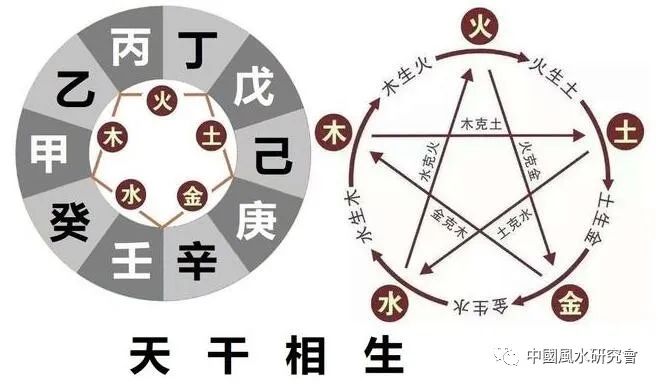
2. Controlling: Based on the principles of same-type control and Five Element control, Yang controls Yang, Yin controls Yin, following the controlling cycle of the Five Elements.
Jia Wood controls Wu Earth, Yi Wood controls Ji Earth, Bing Fire controls Geng Metal, Ding Fire controls Xin Metal, Wu Earth controls Ren Water, Ji Earth controls Gui Water, Geng Metal controls Jia Wood, Xin Metal controls Yi Wood, Ren Water controls Bing Fire, Gui Water controls Ding Fire.
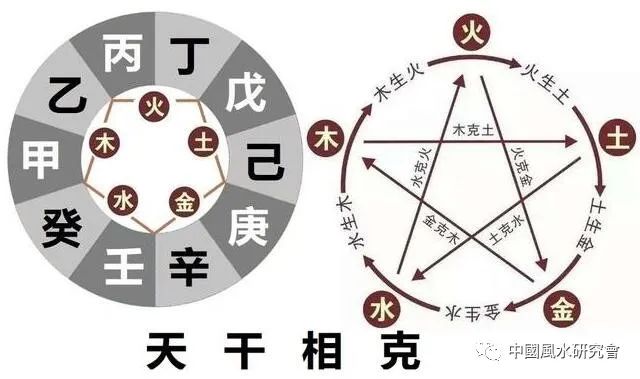
3. Harmonizing: Following the rules of Yin-Yang harmonization and Five Element control, the attributes of Yin and Yang are opposite, and the attributes of the Five Elements are controlling.
The Five Harmonies of the Heavenly Stems (Five Harmonies: 1. Five groups harmonize, Five Harmonies; 2. Every five positions harmonize, Five Harmonies): Jia and Ji harmonize, Yi and Geng harmonize, Bing and Xin harmonize, Ding and Ren harmonize, Wu and Gui harmonize. Subscribe to the account “Yijing Tianxia”. (Jia Wood harmonizes with Ji Earth, Yi Wood harmonizes with Geng Metal, Bing Fire harmonizes with Xin Metal, Ding Fire harmonizes with Ren Water, Wu Earth harmonizes with Gui Water)
Jia and Ji harmonize to transform into Earth, Yi and Geng harmonize to transform into Metal, Bing and Xin harmonize to transform into Water, Ding and Ren harmonize to transform into Wood, Wu and Gui harmonize to transform into Fire.

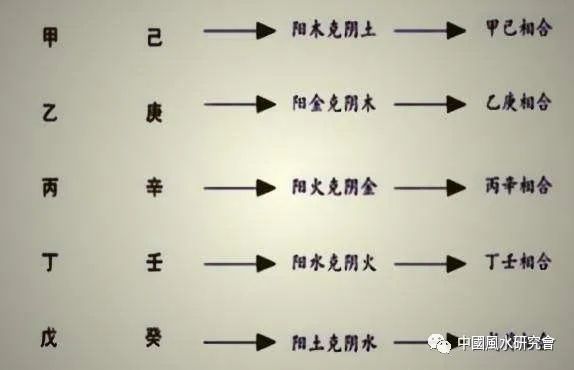
4. Conflicting: Following the rules of directional conflict, same-type conflict, and Five Element control, East conflicts with West, South conflicts with North, Yang conflicts with Yang, and Yin conflicts with Yin. The Five Elements control each other.
Jia and Geng conflict, Yi and Xin conflict, Bing and Ren conflict, Ding and Gui conflict.
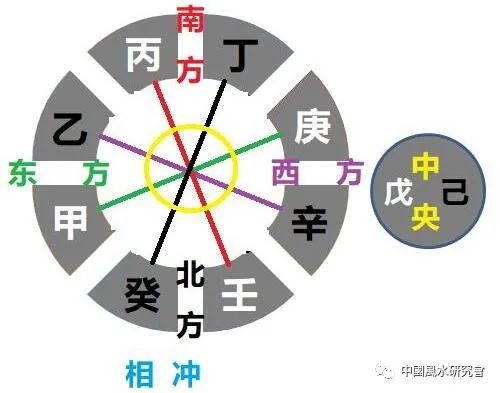
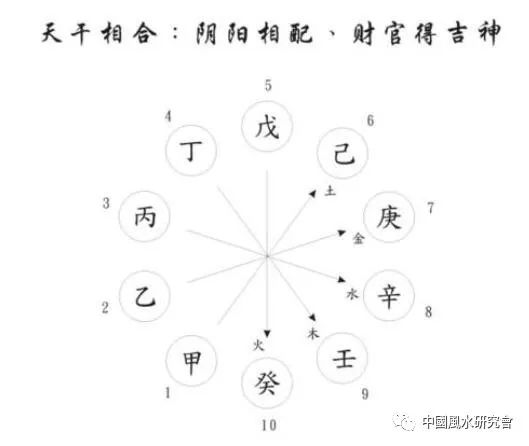
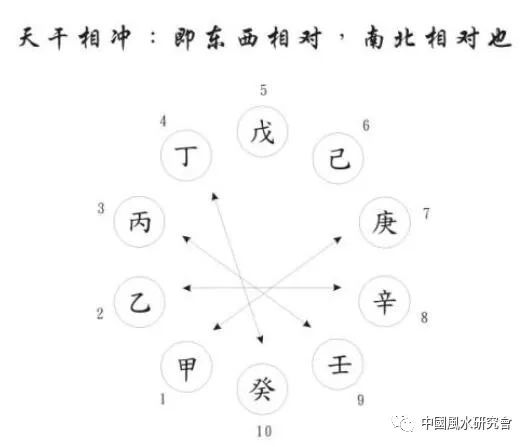
Earthly Branches
Correspondence of the Twelve Earthly Branches with the Zodiac
Zi, Chou, Yin, Mao, Chen, Si, Wu, Wei, Shen, You, Xu, Hai
↓ ↓ ↓ ↓ ↓ ↓ ↓ ↓ ↓ ↓ ↓ ↓
Rat, Ox, Tiger, Rabbit, Dragon, Snake, Horse, Goat, Monkey, Rooster, Dog, Pig
Correspondence of the Twelve Branches with the Months
First Month corresponds to Yin, Second Month corresponds to Mao, Third Month corresponds to Chen, Fourth Month corresponds to Si, Fifth Month corresponds to Wu, Sixth Month corresponds to Wei, Seventh Month corresponds to Shen, Eighth Month corresponds to You, Ninth Month corresponds to Xu, Tenth Month corresponds to Hai, Eleventh Month corresponds to Zi, Twelfth Month corresponds to Chou
Conflicts among the Twelve Branches: Zi conflicts with Wu, Chou conflicts with Wei, Yin conflicts with Shen, Mao conflicts with You, Chen conflicts with Xu, Si conflicts with Hai,
Three Harmonies:
The Shen-Zi-Chen harmony forms the Water group; the Hai-Mao-Wei harmony forms the Wood group; the Yin-Wu-Xu harmony forms the Fire group; the Si-You-Chou harmony forms the Metal group.
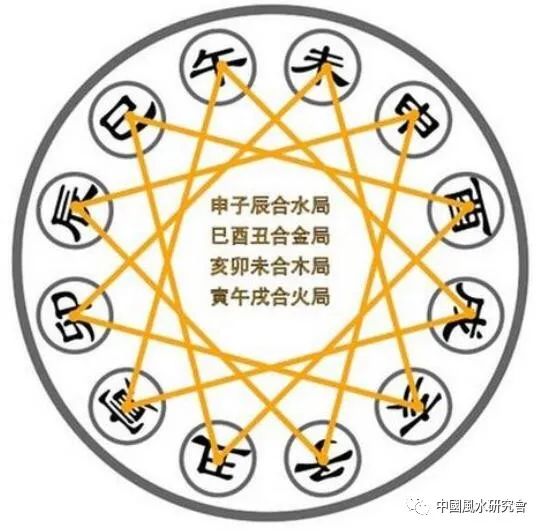
Eight Trigrams
1. Basic Knowledge of the He Tu (The arrangement is based on the Five Elements of the He Tu)
Mnemonic:
One and Six share the same ancestor in the North,
Two and Seven share the same path in the South,
Three and Eight are friends in the East,
Four and Nine are companions in the West,
Five is in the center.

2. Basic Knowledge of the Luo Shu
Mnemonic:
Wearing Nine and stepping on One,
Left Three and Right Seven,
Two and Four are shoulders,
Six and Eight are feet,
Five is in the center.
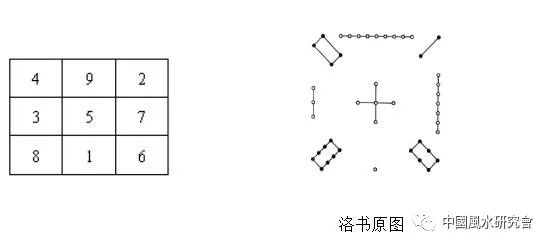
Eight Trigrams
The Eight Trigrams are Qian, Kun, Zhen, Xun, Kan, Li, Gen, and Dui, which the ancients used to represent various phenomena in nature. Qian represents Heaven, Kun represents Earth, Zhen represents Thunder, Xun represents Wind, Kan represents Water, Li represents Fire, Gen represents Mountain, and Dui represents Marsh.
The most basic symbols that constitute the Eight Trigrams are called Yao, which are divided into Yin and Yang; Yang Yao is represented as “—”, and Yin Yao as “——”. Every three Yao form a hexagram, symbolizing Heaven, Earth, and Humanity. Every two hexagrams can overlap to form a double hexagram, with the upper hexagram referred to as the upper hexagram (outer hexagram) and the lower hexagram referred to as the lower hexagram (inner hexagram). There are a total of sixty-four double hexagrams, known as the sixty-four hexagrams.
Specifically, the Eight Trigrams are represented by symbols as shown below.
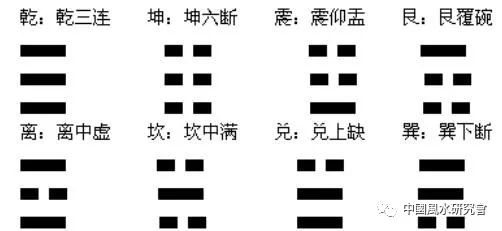
Qian, Kun, Zhen, Xun, Kan, Li, Gen, Dui. For easier memorization, the ancients composed a song using the characteristics of the Eight Trigrams, which we can use to familiarize ourselves with the Eight Trigrams. The song goes: “Qian has three unbroken lines, Kun has six broken lines, Zhen is like a bowl, Gen covers a bowl, Dui has a missing top, Xun has a broken bottom, Li is empty in the middle, Kan is full in the middle.”
Learning the Pre-Heaven and Post-Heaven Eight Trigrams:
Pre-Heaven Eight Trigrams Sequence: Qian one, Dui two, Li three, Zhen four, Xun five, Kan six, Gen seven, Kun eight
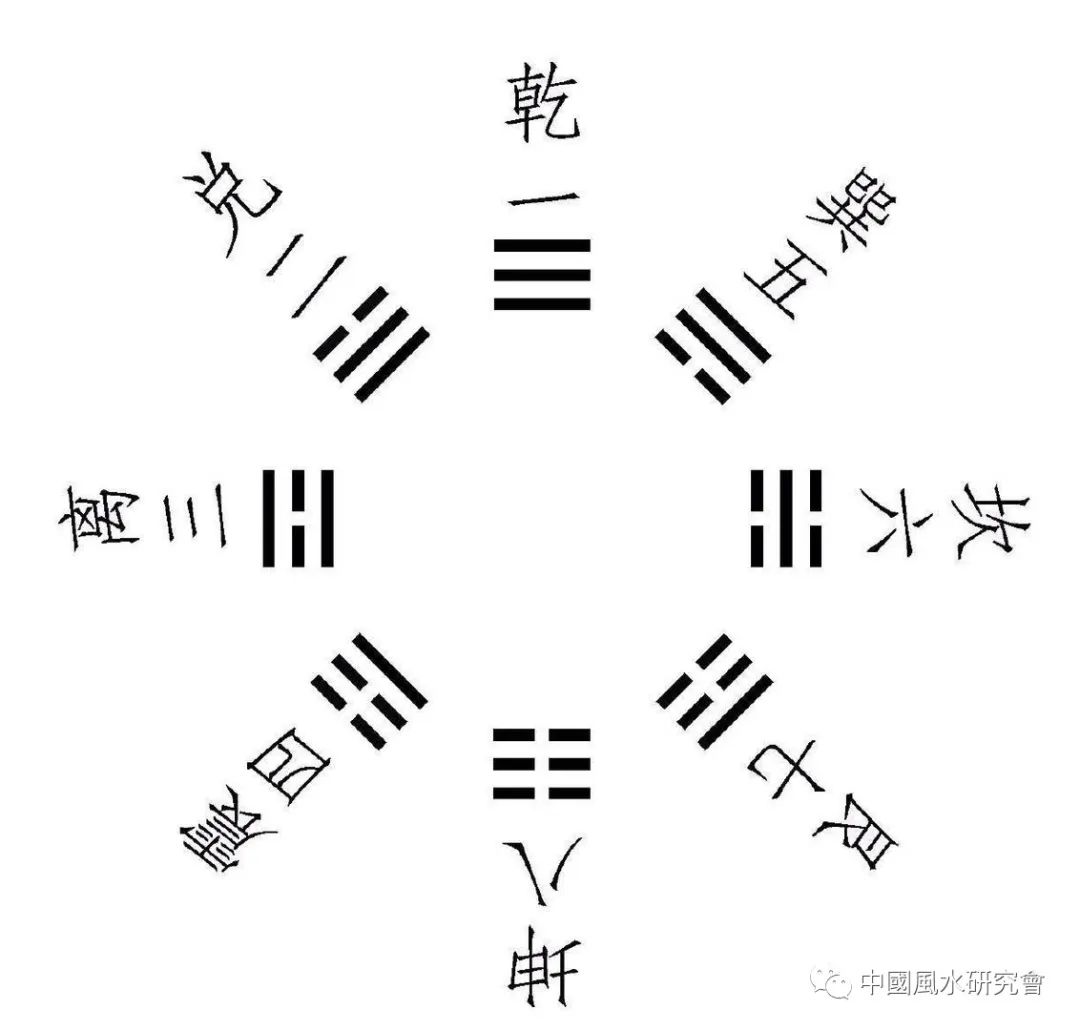
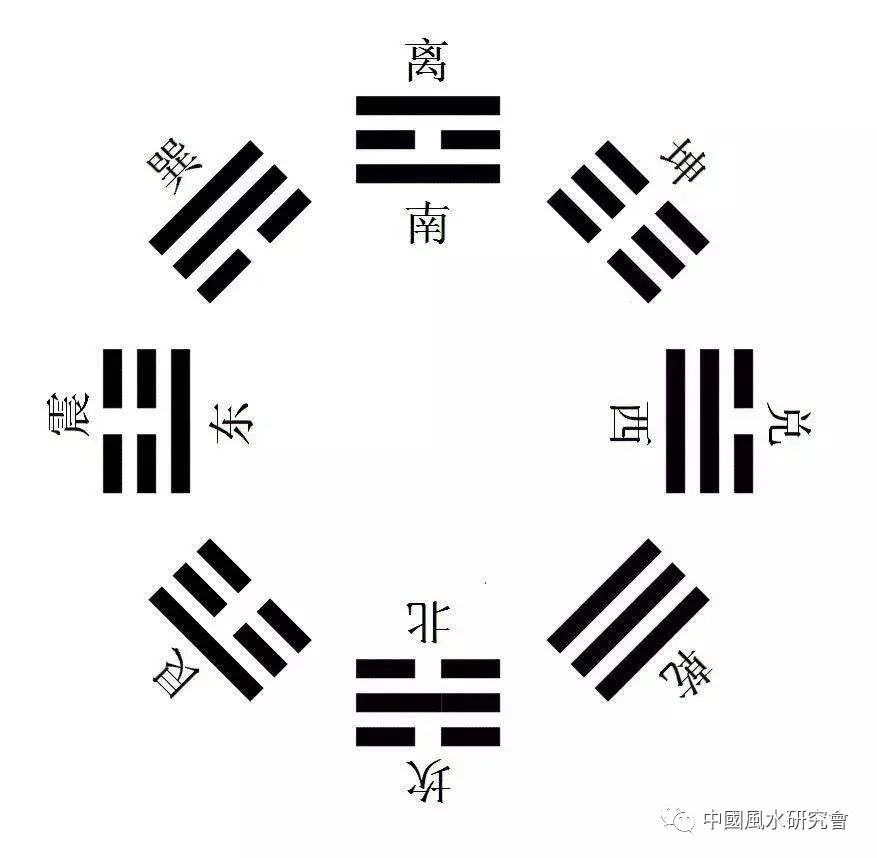
Post-Heaven Eight Trigrams Sequence: Kan one, Kun two, Zhen three, Xun four, Center five, Qian six, Dui seven, Gen eight, Li nine
Learning the Twenty-Four Mountains
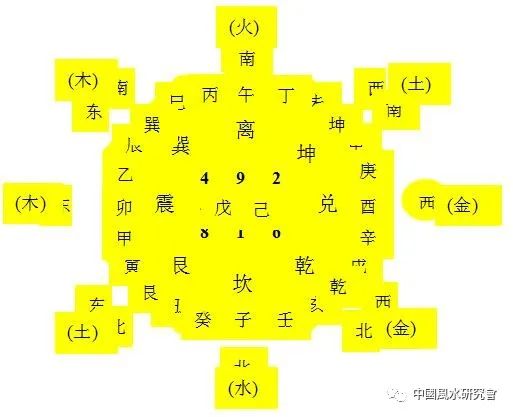
(1) The Eight Trigrams govern the Twenty-Four Mountains
The Eight Trigrams govern the Twenty-Four Mountains, with each trigram governing three mountains, serving as the basis for Feng Shui.
Qian trigram governs the Xu, Qian, and Hai mountains;
Kan trigram governs the Ren, Zi, and Gui mountains;
Gen trigram governs the Chou, Gen, and Yin mountains;
Zhen trigram governs the Jia, Mao, and Yi mountains;
Xun trigram governs the Chen, Xun, and Si mountains;
Li trigram governs the Bing, Wu, and Ding mountains;
Kun trigram governs the Wei, Kun, and Shen mountains;
Dui trigram governs the Geng, You, and Xin mountains;
(2) Understanding Directional Terms
Four Dimensions: Qian, Xun, Gen, Kun; Four Cardinal Directions: Zi, Wu, Mao, You;
Four Yang Stems: Jia, Geng, Ren, Bing; Four Earths: Chen, Xu, Chou, Wei;
Four Long Lives: Yin, Shen, Si, Hai; Four Yin Stems: Yi, Xin, Gui, Ding;
(3) How to Determine the Orientation and Direction of a House?
For a standalone house, determine the orientation based on the entire building’s location, not using the main door or garage door. However, also consider the entrance doors;
For a multi-story building:
If it has more than three floors or more than two households, determine the orientation based on the main entrance of the building. If there are multiple doors, use the door number or sign as a reference.
For residential buildings with multiple units:
Use the entrance of the residential unit to determine the orientation;
For shops in a mall:
Use the individual shop’s entrance to determine the orientation.

